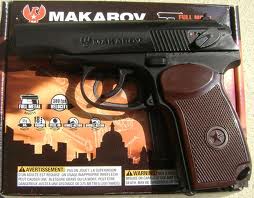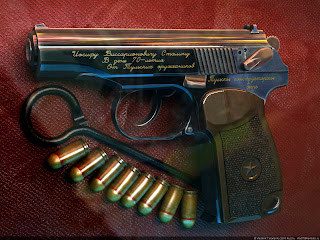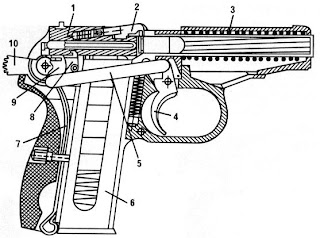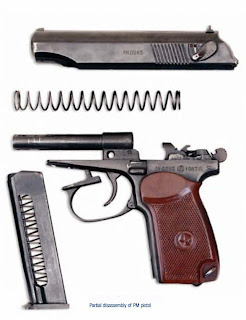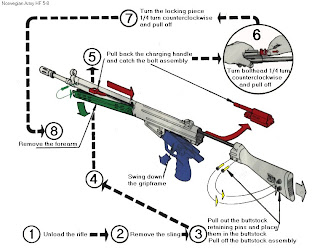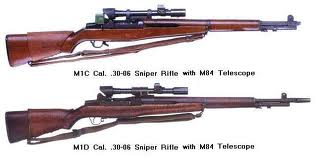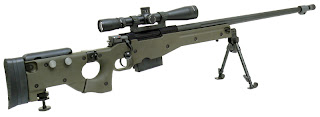Wednesday 21 December 2011
Sunday 11 December 2011
DShK دوشکا gun
The requirement for a heavy machine gun appeared in 1929. The first such gun, the Degtyaryov, Krupnokalibernyi (DK, Degtyaryov, Large calibre), was built in 1930 and this gun was produced in small quantities from 1933 to 1935.
The gun was fed from a drum magazine of only thirty rounds, and had a poor rate of fire. Shpagin developed a belt feed mechanism to fit to the DK giving rise, in 1938, to the adoption of the gun as the DShK 1938. This became the standard Soviet heavy machine gun in World War II.
Read More............
Wednesday 7 December 2011
Makarov pistol Detail
The PM (Pistolet Makarova, Russian: Пистолет Макарова) is a semi-automatic pistol design. Under the project leadership of Nikolay Fyodorovich Makarov, it became the Soviet Union's standard military side arm from 1951-1991
Read More.............
Read More.............
Sunday 4 December 2011
Heckler & Koch G3
The G3 is a 7.62mm battle rifle developed in the 1950s by the German armament manufacturer Heckler & Koch GmbH (H&K) in collaboration with the Spanish state-owned design and development agency CETME (Centro de Estudios Técnicos de Materiales Especiales).
Read More...........
Read More...........
Friday 2 December 2011
Wednesday 30 November 2011
Sniper rifle 4
In military and law enforcement terminology, a sniper rifle is a precision-rifle used to ensure more accurate placement of bullets at longer ranges than other small arms. A typical sniper rifle is built for optimal levels of accuracy, fitted with a telescopic sight and chambered for a military centerfire cartridge. The term is often used in the media to describe any type of accurized firearm fitted with a telescopic sight that is employed against human targets, although "sniping rifle" or "sniper's rifle" is the technically correct fashion to refer to such a rifle.
Monday 21 November 2011
Air Guns
- "Air rifle" and "Air pistol" redirect here. For other uses, see Air gun (disambiguation)
More Read..............
Thursday 17 November 2011
M16 Gun Detail
The M16 (officially Rifle, Caliber 5.56 mm, M16) is the United States military designation for the AR-15 rifle adapted for both semi-automatic and full-automatic fire. Colt purchased the rights to the AR-15 from ArmaLite, and currently uses that designation only for semi-automatic versions of the rifle. The M16 fires the 5.56×45mm NATO cartridge. The rifle entered United States Army service and was deployed for jungle warfare operations in South Vietnam in 1963,[4] becoming the U.S. military's standard service rifle of the Vietnam War by 1969,[5] replacing the M14 rifle in that role. The U.S. Army retained the M14 in CONUS, Europe, and South Korea until 1970. Since the Vietnam War, the M16 rifle family has been the primary service rifle of the U.S. armed forces.
More...............
More...............
M16 Rifle
The Armed Forces in Vietnam used many kinds of weapons from awesome B-52 bombers to the lowly bayonet. We had the ability to destroy enemy bases in a single attack, or mow down a hundred men in one sweep. But the weapon most important to the man on the ground was his M-16 rifle. It was the weapon of the infantryman - and you felt naked without it. It was as natural to have it beside you as it was to eat three meals a day.
The rifle was easy to care for. Each man carried a rifle rod, a wad of bore patches, and LSA silicone lubricant, to clean the rifle. The rifle split in two for cleaning. You removed a pin and it opened like a shotgun. The entire bolt and firing pin group came out for disassembly and cleaning.
I decided to try cleaning the rifle on the run, even though I might trip again while I was doing it and lose one of the small pins in the mud. I wiped my hands free of mud and opened the rifle. Pulling the bolt assembly out of the frame, I placed the open rifle under one arm and cradled the assembly in both hands. I stripped away the mud and grit as best I could, then took the assembly apart, clenching the tiny parts firmly in my fist. I squeezed half a bottle of LSA over the parts, trying to wash away the dirt that was left, and then began the task of putting everything back together.
Yes, my security blanket was my trusty M-16. I fixed a carrying strap to sling it from my shoulder, the safety/single/auto switch just above my thumb. Some guys carried the rifle over their shoulder like a shovel, but not me. I wanted it where I could use it right now, if the need arose. I'll not forget my M-16, for it served me well. It kept me alive. May it rust in peace.
Notes I wrote down during M-16 training class while in Advanced Infantry Training at Fort Polk:
M-16 Rifle, 39 inches long, 6.5 lb empty, 7.6 lb loaded, uses ball and tracer ammo only, a full magazine weighs 2/10 lb, magazine carries 20 rounds (but we actually loaded 19), gas operated, air cooled, selector switch has 3 positions (safe, semi-auto, automatic). Maximum range is 2,653 meters, maximum effective range is 460 meters. Rate of fire is 650-700 rounds per minute on full automatic, 150-200 rounds per minute when reloading 20-round magazines.The following information came from a pocket reference card we received in Vietnam:
Subscribe to:
Posts (Atom)













